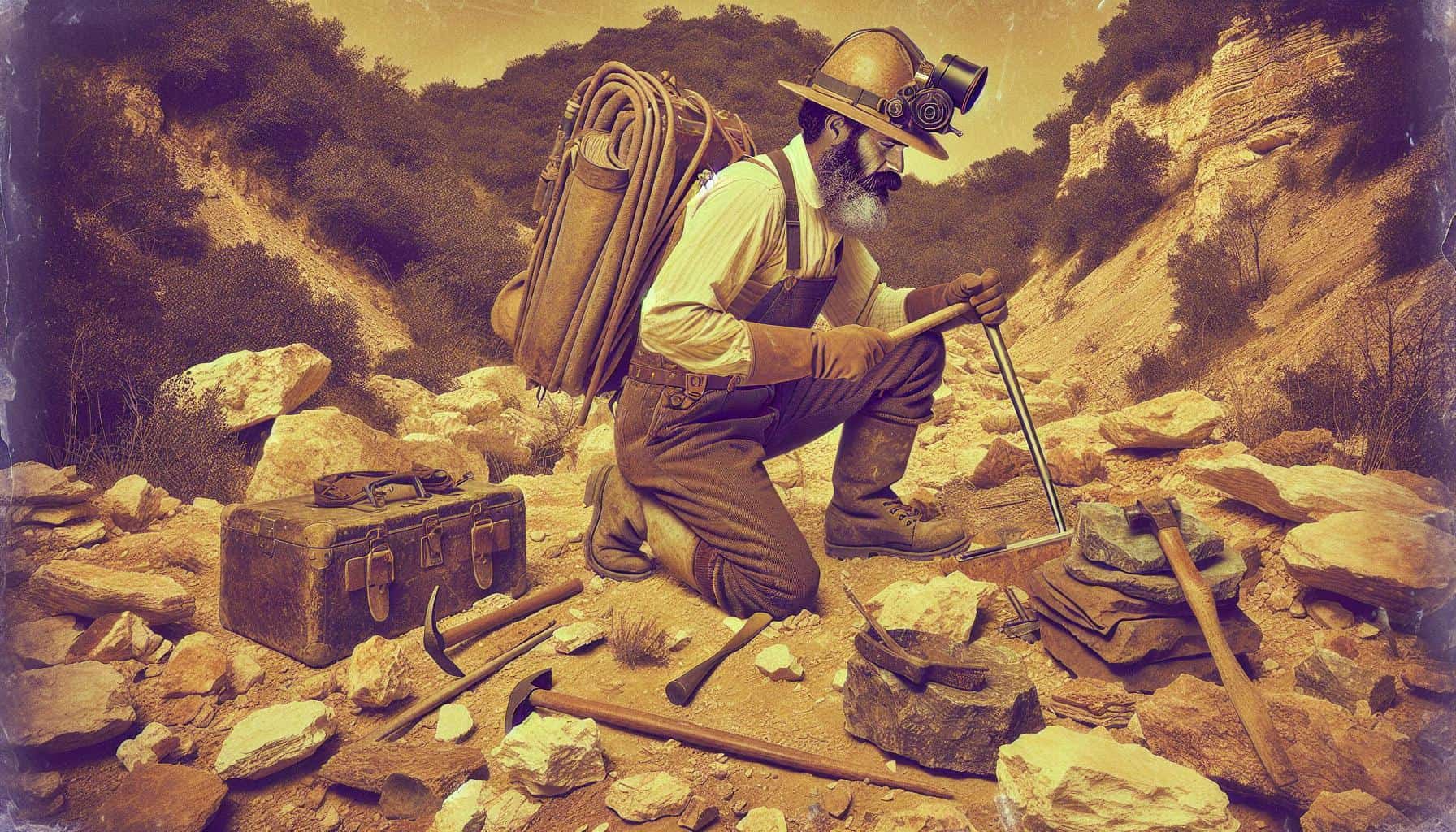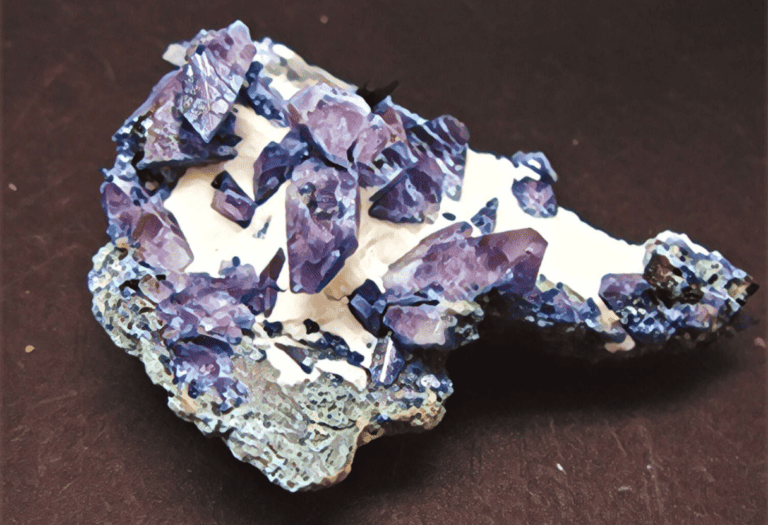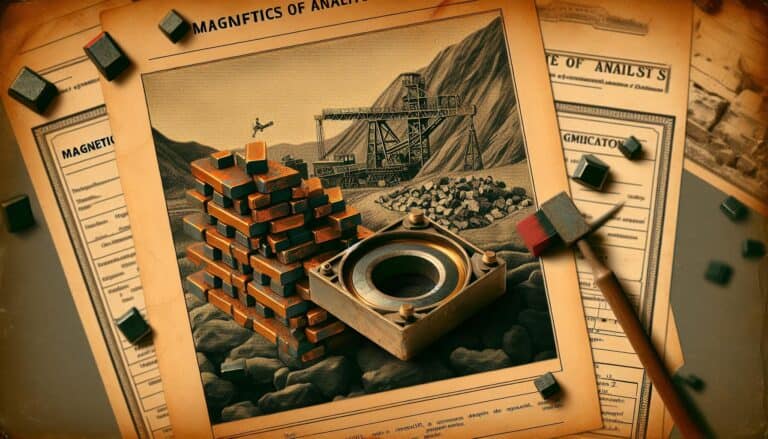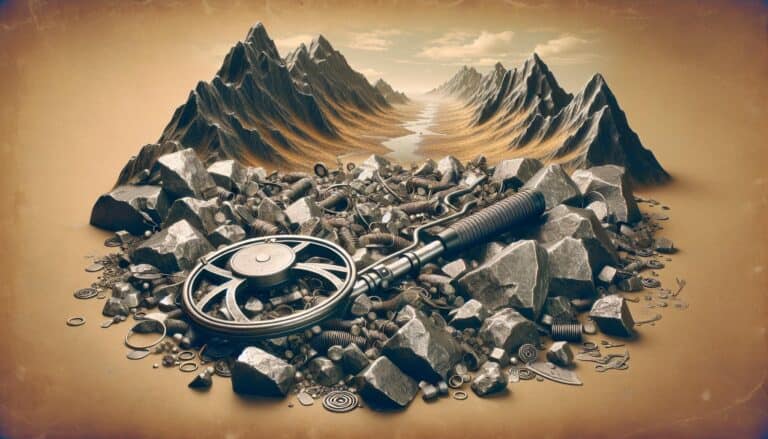Ever wondered where to uncover hidden geological treasures in Wisconsin?
You’re in luck! The Badger State is a haven for rockhounds seeking to dig up everything from glimmering quartz to ancient fossils. Whether you’re a seasoned collector or just starting out, Wisconsin’s diverse terrain offers a plethora of sites ripe for exploration.
You’ll find that the state’s rich glacial history has left behind a treasure trove of minerals and crystals. From the shores of Lake Superior to the rolling hills of the Driftless Area, each locale presents unique opportunities to add to your collection.
Get ready to embark on an adventure that’ll not only fill your pockets but also enrich your knowledge of Wisconsin’s geological wonders.
Rockhounding in Wisconsin offers diverse finds from Lake Superior agates to glacially-deposited minerals. Explore the Driftless Area for galena and fossils, Lake Superior’s shores for agates, and central Wisconsin quarries for quartz. Remember to obtain permission for quarry access and adhere to ethical rockhounding practices.
Wisconsin Rockhounding Locations
Wisconsin’s varied terrain offers several prime rockhounding locations, each boasting unique geological features and a chance to unearth distinct minerals and fossils. Here’s a rundown of must-visit sites:
The Shores of Lake Superior are famous for their yield of agates, specifically the Lake Superior Agate, known for its stunning banded patterns. These rocky beaches are a paradise for collectors, offering smooth, wave-polished gems that are both visually appealing and geologically significant.
The Driftless Area, untouched by glaciers, is another hotspot. Its landscape is rich in mineral deposits, including galena, quartz crystals, and fossilized remnants from a prehistoric era. Here are some notable spots:
- Grant County: Dotted with old mine dumps, it’s ripe for finding galena, a lead ore mineral with a metallic luster.
- Crawford County: A haven for fossil enthusiasts, this area offers limestone and shale formations housing ancient marine fossils.
Quarries in Central Wisconsin invite those interested in calcite and quartz specimens. However, you’ll need to obtain permission before visiting these active mining sites. Key quarries worth seeking access:
- Quartz-rich Marathon County: Collectors may find perfect hexagonal crystals.
- Calcite at Wood County: Promises vibrant specimens in unexpected forms.
Rockhounds shouldn’t overlook Wisconsin’s Western Region. The Mississippi River Valley is particularly fruitful, yielding geodes in the limestone and dolostone bluffs. These geodes may contain crystals like quartz and chalcedony, presenting an exciting challenge for any rock collector.
Embarking on a rockhounding adventure in Wisconsin isn’t just about what you can find, it’s about experiencing the thrill of discovery and connecting with the ancient history of the land. Dive into these locations and uncover nature’s hidden gems beneath your feet.
What Gemstones are Found in Wisconsin?
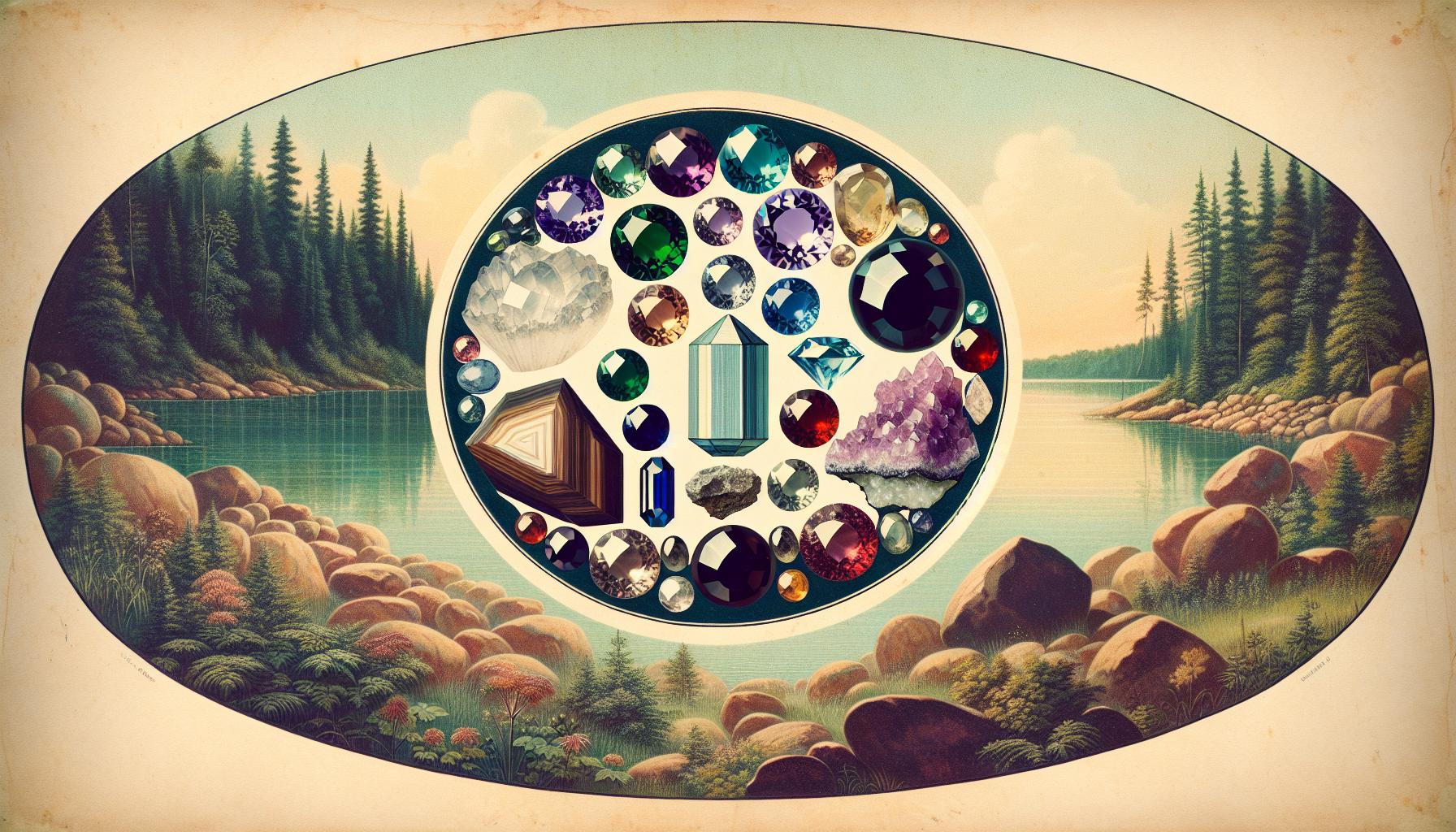
Venturing across Wisconsin’s diverse landscapes, you’re likely to stumble upon a variety of gemstones, each with its unique allure. Wisconsin’s state mineral, galena, is not a gemstone, yet its presence often signifies a region rich in other mineral finds. In your pursuit of gemstones, keep an eye out for these precious and semi-precious stones native to the region.
Wisconsin Quartz Varieties
Quartz, recognized for its durability and beauty, prevails throughout the state. You’ll encounter multiple forms:
- Clear Quartz, often found in geodes, is both abundant and collectible.
- Smoky Quartz presents a captivating dark hue, a prize for any enthusiast.
- Amethyst, a purple variant of quartz, can be located in select areas, offering a touch of royal elegance to your collection.
Exploring the geodes of the Mississippi River Valley could reward you with not just quartz but other crystalline wonders as well.
Other Notable Gemstones
Beyond quartz, Wisconsin is home to several other gemstones:
- Agates, particularly the banded Lake Superior Agate, are generously sprinkled along the shores of Lake Superior.
- Jaspers, a form of chalcedony, offer intricate patterns and are often found nearby agates.
In Central and Western Wisconsin, enthusiasts may find:
- Beryl, in smaller quantities, is noteworthy for its green and blue varieties, emerald, and aquamarine respectively.
- Garnets are found occasionally and are coveted for their deep reds and greens.
- Calcite, while not traditionally seen as a gemstone, forms beautiful crystals that exhibit diverse colors and formations.
Ensure to seek permission when accessing private lands or quarries, as many of these areas are the best bets for discovering these hidden gems.
When setting out on your rockhounding adventure, remember that patience and persistence are as crucial as the tools you bring along. Keep your eyes peeled for the subtle glitter amongst the rocks and soil; the next amazing find could be just underfoot. With the rich geological history of Wisconsin, who knows what natural treasures you’ll unearth?
What Sedimentary Rocks You Can Find in Wisconsin?

When you’re out exploring Wisconsin’s diverse geological landscapes, keep an eye out for the wide array of sedimentary rocks that the region has to offer. These rocks are a time capsule, holding centuries of Earth’s history, and they’re prevalent in several parts of the state, especially in ancient seabeds and areas once covered by oceans.
The sedimentary rocks you might encounter include:
- Sandstone, particularly the Cambrian sandstone found in central Wisconsin, notable for its beautiful hues and granularity.
- Shale, often discovered in the southwestern part of the state, these layers tell a story of the ancient environments of Wisconsin.
- Dolomite, akin to limestone but with a higher magnesium content, and limestone itself, which covers large parts of eastern Wisconsin. Here, you’ll find the highly sought-after Galena-Dolomite with its characteristic cubic crystal formations.
Each location offers up a unique set of mixed sediments, providing a puzzle-like understanding of historical deposits that contributed to the state’s geological formation. The Milwaukee Formation, for example, includes a vast collection of silurian reef deposits, highlighting Wisconsin’s connection to ancient marine ecosystems.
What’s exciting is that these sedimentary rocks often house fossils, making Wisconsin a palaeontologist’s playfield. From coral and trilobites to brachiopods, you might stumble upon remnants of ancient life, etching a deeper connection to the Earth’s past.
Remember, while you’re searching for these geological treasures, always tread lightly and respect the natural formations. Many sedimentary rocks in Wisconsin are part of delicate ecosystems, and it’s crucial to maintain the integrity of these sites for both ecological balance and future generations of rock enthusiasts.
With patience and a keen eye, you’ll be able to identify and appreciate the multitude of sedimentary rocks that Wisconsin has locked away in its vast geological library.
What Metamorphic Rocks are found in Wisconsin?
As you delve into the depths of Wisconsin’s geology, you’ll discover that the state’s metamorphic rocks are just as intriguing as its more easily spotted sedimentary cousins. These rocks have been transformed by intense heat and pressure, restructuring their minerals into new, more stable forms.
In the northern regions of the state, gneiss and schist are among the metamorphic rocks you’re likely to encounter. These rocks began as sediments or igneous materials that have been profoundly altered, giving them a distinct, banded appearance.
- Gneiss is typically found in the ancient Precambrian terranes, and its composition can reveal much about the conditions under which it was formed.
- Schist is characterized by its thin, flaky layers and can often sparkle with bits of mica or other minerals.
Additionally, quartzite, a hard, non-foliated metamorphic rock, is derived from original quartz sandstones. Quartzite shows up primarily in the Baraboo Range and can be identified by its glassy luster and resistance to weathering.
Central Wisconsin is where you might find marble, which started its geological journey as limestone or dolomite. While occurrences of pure marble in Wisconsin are few, enthusiasts searching might stumble upon this transformative beauty, predominantly within the confines of old quarries.
For a more unique find, keep an eye out for soapstone. Composed primarily of talc, soapstone’s soapy feel makes it an interesting and less common discovery. Soapstone is a testament to the region’s dynamic geological evolution and can be spotted within the state’s more mature geological formations.
Remember that metamorphic rocks can be elusive, hiding in plain sight or tucked away in less traveled locations. Pay attention to road cuts, riversides, and hillsides where erosion may have uncovered these geological treasures. And don’t forget, the hunt for these transformative rocks is best accompanied by careful research and a good map in hand.
What Igneous Rocks can You Find in Wisconsin?
As you delve deeper into Wisconsin’s geological offerings, you’ll be intrigued to find that the state’s igneous rock collection is as rich and varied as its metamorphic counterparts. In the northwestern regions, particularly around the ancient volcanic belts, Basalt and Rhyolite reveal the state’s fiery past.
Wisconsin’s igneous rocks, formed from cooled molten material, include Granite, widely recognized for its grainy texture and durability. Diabase, similar in composition to basalt, is another example, frequently uncovered in the form of intrusions, dikes, and sills.
- Granite is commonly spotted in the northern areas, sporting a speckled pattern of white, black, and pink hues.
- Diabase tends to appear darker and is particularly interesting for those fascinated by its crystalline depth.
Greenstone belts in Wisconsin are noteworthy as well. These regions contain altered volcanic rocks that are essentially metamorphosed basalt. They speak volumes about the tectonic activities that shaped the area.
If you’re on the hunt for Wisconsin’s igneous varieties, these locales should be on your list:
- Baraboo Range: Known for some of the most pristine exposures of Baraboo Quartzite, it also harbors Granite and Rhyolite.
- Keweenaw Peninsula: Though primarily in Michigan, it extends into Wisconsin, offering an array of Copper Country Volcanics and associated igneous rocks.
Bear in mind the significance of appropriate equipment and safety measures while exploring rugged areas. Rockhounding entails more than just the hunt; it’s about the experience, the learning, and embracing the journey.
When traversing the state’s diverse igneous landscapes, you’re engaging with stories millions of years in the making. Whether it’s the pink-hued granite or the ancient greenstone, Wisconsin’s igneous treasures await your discovery, bringing you closer to the Earth’s fiery history.
Panning for Gold in Wisconsin
Wisconsin may not be the first state that comes to mind when you think of gold panning, but it’s a practice that has attracted prospectors to the state for years. While you’re unlikely to strike it rich, panning for gold can be a rewarding hobby, offering the excitement of discovery and the allure of natural beauty.
Streams and riverbeds in Wisconsin, particularly in the northern and western parts of the state, are known to carry fine gold deposits. The glacial drifts, carrying materials from gold-bearing areas in Canada, are largely responsible for depositing gold in Wisconsin’s sediment layers.
Before you set out with your pan and sieve, do your research on public lands and local regulations. Gold panning often requires a permit, and you’ll want to ensure you’re prospecting in permitted areas. Start by checking with the Wisconsin Department of Natural Resources for guidance on locations and compliance with state laws.
Prime Locations for Prospecting
- The Flambeau River
- The Chipppewa River
- Creeks in the Blue Hills
When selecting a spot for gold panning, look for areas where heavier materials have settled. Inside bends of rivers, where water slows down, and at the foot of waterfalls are promising spots, as gold tends to sink and accumulate in such places.
Tools of the Trade
To get started, you’ll need a few essential tools:
- A gold pan
- A shovel or trowel
- A sieve or classifier
- A snuffer bottle
Investing in a sluice box can also be worthwhile if you’re dedicated to the hobby. The sluice box enhances gold recovery by creating artificial rapids that mimic the natural filtering action of a river.
In your quest for gold in the Badger State, always remember to leave the environment as you found it. Minimize disturbances to soil and riverbanks, and avoid disrupting wildlife habitats by following the principles of Leave No Trace. Your consideration and care for the environment make the pastime of gold panning sustainable for everyone to enjoy.
Rocks and Minerals Found in Wisconsin
When you’re on the hunt for rocks and minerals in Wisconsin, you’re in for a diverse geological treat. Wisconsin’s geology provides a veritable playground for rockhounds with an array of specimens ranging from common finds to precious rarities.
Quartz is one of the most abundant minerals you’ll stumble upon. It comes in many forms, including the clear, crystalline variety often sought by collectors. Calcite, with its many crystal shapes and sizes, is another common find. These minerals are readily found in areas with limestone and dolomite deposits, typically located in the eastern and southern parts of the state.
Galena, a heavy, metallic mineral, is the natural mineral form of lead sulfide and is frequently associated with the history of mining in Wisconsin. Many rockhounds look for galena in the southwestern part of the state, a region known for its long history of lead and zinc mining.
| Mineral | Common Locations in Wisconsin |
|---|---|
| Quartz | Eastern and Southern Regions |
| Calcite | Eastern and Southern Regions |
| Galena | Southwestern Region |
Copper deposits can lead you to some exciting finds as well. Native copper, with its distinctive reddish hue, is a relatively rare and prized find. Searching old mine dumps in the northern regions can yield pieces of this conductive metal. Agates, particularly the beautiful Lake Superior agates, are another coveted find among Wisconsin rockhounders. Their banded patterns and rich colors make them a unique addition to any collection.
Remember to research and gain permission where necessary as some of these mineral collecting sites are on private property or protected lands. Tools like geological maps and local clubs can aid immensely in finding the right spots where these treasures lie hidden, just waiting for the keen-eyed enthusiast to uncover them. Always ensure that your rockhounding adventure is both responsible and respectful to the environment. Keep an eye out for signs that indicate whether a location is open for collection and abide by local guidelines at all times.
Where Can I Find Fossils in Wisconsin?
Wisconsin is not only a treasure trove for rocks and minerals but a fossil hunter’s haven too. As you venture out on your rockhounding journey, you’ll find that fossils are abundant in several areas across the state often nestled in limestone and shale deposits.
The Western Part of the State is particularly known for its rich fossil locales. Here, you have a good chance of uncovering marine fossils that date back to the Ordovician period. In contrast, the Ridgeway Pine River preserve in the south is famous for its diverse Devonian period fossils.
Key spots for fossil hunting in Wisconsin include:
- Grant County: This county’s limestone quarry exposes you to trilobites, brachiopods, and crinoids.
- Waukesha County: An old, now submerged quarry yields coral, cephalopods, and trilobite fossils.
- Dane County: Pay a visit to the roadcuts along the highways to possibly uncover trilobites and other marine fossils.
Always remember that some locations may require permission to collect, and it’s essential to respect property rights along with state laws regarding fossil collection.
Useful fossil-hunting tools include:
- Rock hammers
- Chisels
- Brushes
Equipping yourself with the right tools not only makes your hunt more successful but also ensures the preservation of these ancient treasures for scientific study. It’s worth noting that the University of Wisconsin Geology Museum is a great place to learn more about the types of fossils you might find and how to identify them. They also provide resources and guides on the best practices for fossil hunting in Wisconsin.
When planning your fossil finding expedition, authoritative sources like geological surveys and local rockhounding clubs can provide valuable information on updated regulations and potentially fruitful new locations. This knowledge not only expands the potential for discovery but also promotes a responsible and ethical approach to rockhounding.
Wisconsin Rockhounding Laws & Regulations
When you’re planning your rockhounding adventure in Wisconsin, it’s crucial to stay informed about local regulations. Wisconsin State Law stipulates that collecting rocks, minerals, and fossils on state land is subject to certain rules and restrictions to ensure environmental protection and cultural preservation.
First and foremost, remember that it’s illegal to rockhound in State Parks without a permit. If you’re caught removing specimens without authorization, you might face fines or other penalties. To avoid trouble, always check with park officials before beginning your hunt.
Rockhounding on private property requires explicit permission from the landowner. Trespassing to collect samples is against the law and disrespectful to property owners. Always obtain consent and inquire about any specific conditions they may have.
National Forests generally allow rockhounding for personal use, but the removal of significant quantities or commercial collection is prohibited. Stick to surface collecting; excavation and use of power tools are not allowed without special permits.
Here’s a concise list of do’s and don’ts:
- Do obtain permission for collecting on private land or in state parks
- Do familiarize yourself with the American Federation of Mineralogical Societies’ Code of Ethics
- Don’t remove specimens from designated Wilderness Areas
- Don’t use explosives or power equipment without explicit permission
For accurate and up-to-date information on laws and permits, get in touch with the Department of Natural Resources (DNR). They can provide you with the latest regulations and guidelines for rockhounding in the state.
Remember that laws are in place to protect Wisconsin’s natural heritage. By following these regulations, you’ll ensure that the hobby of rockhounding remains sustainable and enjoyable for everyone.
Rockhounding Tips for Beginners in Wisconsin
Whether you’re a fledgling rockhound or a seasoned collector, knowing the ropes can help you get the most out of your rockhounding experience in Wisconsin. Let’s dig into some essential tips that will prepare you for a successful outing.
Gearing Up: Essential Tools for Rockhounding
You’re about to start a fascinating journey into the world of rocks and minerals, and the right tools are your passport to success. Here’s what you’ll need to gear up:
- Geologist’s hammer or rock pick: This is critical for breaking rocks and extracting specimens.
- Chisels and screwdrivers: Great for prying out crystals and fossils.
- Safety glasses or goggles: Protect your eyes from flying rock chips.
- Durable gloves: To keep your hands safe from sharp edges and rough surfaces.
- Sturdy containers: Egg cartons or separate boxes work well for keeping your finds safe.
- Field guide and maps: To help identify your discoveries and navigate areas of interest.
Remember, as a beginner, you don’t need to splurge. Invest in basic, reliable gear and you’ll be ready to start your adventure.
Safety Tips While Rockhounding
Your safety should always come first. Here are some guidelines to keep in mind while you’re out exploring:
- Always inform someone of your location and expected return time.
- Be wary of the terrain; watch out for loose rocks, steep slopes, and potential hazards.
- Hydration is key; bring plenty of water, especially during warmer months.
- Dress appropriately for the weather and wear layers if you’re heading to different elevations.
- Don’t forget a first-aid kit for any minor injuries and a whistle in case of emergency.
Keep these safety tips in mind and you’ll have a more enjoyable and worry-free rockhounding experience.
Legal Guidelines for Rockhounding Enthusiasts
Navigating the legal landscape is essential for a hassle-free rockhounding endeavor in Wisconsin:
- Ensure you know the boundaries of any public lands and obtain permits if required.
- Respect private property; always seek permission before entering and collecting.
- Mind the environment; leave the site as you found it, minimizing disturbance to wildlife and natural features.
- Avoid collecting in state parks and nature reserves unless explicitly permitted to do so.
- Familiarize yourself with Wisconsin’s regulations on mineral collecting, which are often updated by the DNR.
Adhering to these legal guidelines helps maintain the environment and the thrill of rockhounding for future enthusiasts.
Conclusion: Wisconsin Rockhounding Guide & Map
Venturing into the natural beauty of Wisconsin for rockhounding is an adventure you won’t forget.
Equipped with the right tools and knowledge of safety, you’re set to explore the hidden treasures beneath the surface. Remember, respecting the legalities of rockhounding preserves this pastime for future enthusiasts.
So grab your gear, follow the guidelines, and happy hunting! Wisconsin’s geological wonders await.

